
Anton Brand/shutterstock.com
Humpty Dumpty sat on a wall
Humpty Dumpty had a great fall
All the king’s horses and all the king’s men
Couldn’t put Humpty together again.
—Mother Goose
I feel like a female Humpty Dumpty. Recently I took a great fall, and now I am in the process of being put together again.
I was diagnosed with rheumatoid arthritis (RA) at age 25. For the past 38 years, I have fought my RA with medications ranging from 13 enteric-coated aspirin per day in 1978 to weekly etanercept injections since 2004. My body bears the scars of 13 orthopedic surgeries, including four total hip arthroplasties, fusions and synovectomies. RA may have contributed to my two cancer diagnoses, as well as my urticarial vasculitis, osteoporosis and a cerebrovascular accident (CVA) at age 31 followed by a miscarriage of my second daughter the same year.
I have fought my RA with a positive attitude supported by cutting-edge knowledge. Under the guidance of several excellent rheumatologists as well as physical and occupational therapists, I have worked to be the best wife, mother, grandmother and registered nurse possible. I thought I knew it all about RA and its effects on my body. I secretly hoped it would burn itself out. I was wrong! RA is not finished with me yet.
My disease continues to prove to me that RA patients have complex and interrelated needs that influence our health status in many ways. We, and those who care for us, need to keep this in mind.
RA Complicated by Osteoporosis
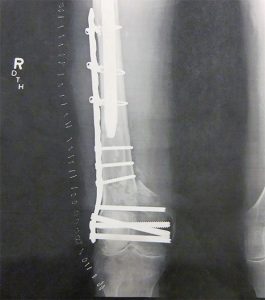
Post-op X-ray shows the repair of the author’s right femur fracture.
Any fall is detrimental, especially to an RA patient who also has osteoporosis. Having experienced compression fractures of my lumbar vertebrae at L2 and L4 in 2013, I successfully completed a full two years of daily teriparatide injections. I anxiously waited to have my post-treatment DXA scan done so we could determine how much my bone density had improved. To my dismay, my bone density could not be accurately measured.
I learned that there must be two consecutive lumbar vertebrae that have not been fractured to obtain a valid result. My lumbar spine did not qualify because both L2 and L4 showed old compression fractures. Also, both of my hips are prosthetic, and the bones of my left wrist have been too damaged by my RA to be measured. What a disappointment after giving myself 730 injections!
RA is not finished with me yet. My disease continues to prove to me that RA patients have complex & interrelated needs that influence our health status in many ways.
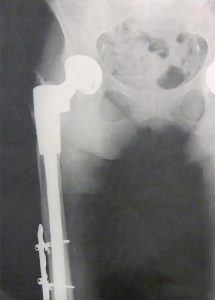
Post-op X-ray shows wire placed around the right femur near a hip prosthesis rod.
My osteoporosis also proved to be influential in the outcome of my fall. I fell in my living room as I reached to arrange pillows on the sofa. I landed on plush carpeting, but as I fell, my right knee hit the rock-hard sofa frame. Immediately, I felt knife-like pain accompanied by tightness as my knee swelled to what felt like a basketball under my jeans.
X-rays revealed a comminuted displaced and angular fracture of the distal right femur, immediately inferior to the femur rod attached to my right hip arthroplasty. This type of fracture is caused by high-impact trauma as in automobile accidents, and it occurs in older people who lack normal bone density. The latter describes me perfectly.
I underwent an open reduction internal fixation (ORIF) to correct the damage to my femur. To prepare me for major orthopedic surgery, several abnormalities in my blood had to be corrected. My RA has caused me to be chronically anemic, shown by a hemoglobin at 7.1 g/dL and hematocrit of 21.3%. I received one unit of packed cells preoperatively. I have taken warfarin daily since my CVA in 1984.
My international normalized ratio (INR) was 2.5, a therapeutic level for anticoagulation, but too high to proceed with surgery. I was given three units of fresh frozen plasma to bring down my INR. Finally, I was ready for surgery.
I learned that it is an RA patient’s responsibility to discern whether the exercises prescribed are appropriate for the complex deficits many of us have. … It was my job to discuss & explore with my therapist whether the exercises prescribed safely met my needs.
Post-Op
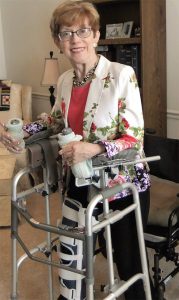
The author uses her platform walker before going to church.
Post-operative orders specified two months of no weight bearing on my right leg—none at all. My bone density is osteopenic at the distal end of my right femur, so my orthopedic surgeon wanted the hardware he used to have ample healing time.
Being an RA patient who has a right shoulder arthroplasty in addition to weakened wrists and finger deformities, I had to use my platform walker to pivot with my left leg. Absolutely no hopping on one foot or crutches were allowed. My platform walker was an odd-looking contraption that accompanied me wherever I went. Other patients stared at it and wondered what planet I came from. Not only was it bulky, but the platforms added weight, which made it heavier for me to move.
I encountered healthcare workers who assured me, “You don’t need to use that. Just grab onto my neck, and I can move you myself.” I politely refused to do this, knowing my upper extremities are weaker than the normal patient’s.
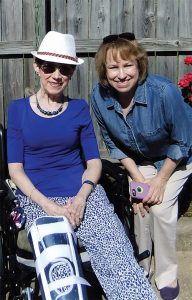
The author with her friend, Lisa Veregge, RN, BSN, taking a walk.
I learned that it is an RA patient’s responsibility to discern whether the exercises prescribed are appropriate for the complex deficits many of us have. What may be safe and appropriate for most orthopedic patients may be unsafe and put excessive stress on an RA patient’s weakened joints. It was my job to discuss and explore with my therapist whether the exercises prescribed safely met my needs. It was a chance to educate others about the unusual needs we RA patients have. The hospitalist who cared for me remarked, “You can tell me how to care for you.”
At the time of this writing, it has been three weeks since my ORIF procedure. The extensive surgical wound on the lateral aspect of my right thigh is well approximated and only slightly tender. I am healing well.
This has not always been the case, however. Many RA patients, including myself, have difficulty with normal wound healing. As a veteran of more than 20 trips to the operating room since 1983, I always prided myself on how well my body could heal with no complications. It took a minor surgery in 2015 to prove me wrong. I discovered a small mass on my upper left thigh, and with my history of two cancer diagnoses, I knew it should not be ignored. A core needle biopsy report showed no malignancy. It described acute areas of reactive fibrosis, fibrovascular proliferation and foamy macrophages, compatible with abscess. I underwent an incision and drainage (I & D) of my thigh abscess. My post-operative course was unremarkable until I noticed purulent drainage oozing from my supposedly healed wound. I was hospitalized with septicemia caused by streptococcus pneumoniae. My wound was reopened twice more because it did not heal properly A referral to a wound clinic was made, and it was there that I learned that RA patients may have difficulty with wound healing. This is yet another possible complication of the RA disease process that must not be ignored.
New Challenges Present
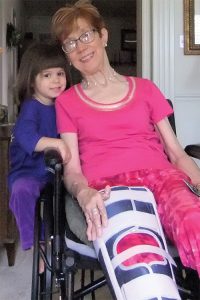
The author with her granddaughter, Kate.
Living with RA has not been easy. It continues to present new challenges as I age. My disease has taught me humility, patience and perseverance as I continue to face new problems that originate from my RA. I am responsible to understand my RA and the complexity of my disease and communicate my needs to others. My goal is to survive my great fall and to be stronger and wiser than before it happened.
Sarah Troxell, RN, BSN, was the nurse coordinator and patient educator for the Coordinated Rheumatology and Pain Management Programs at Mercy Medical Center in Oshkosh, Wis., until her retirement. She is an emeritus member of the ARHP. She now resides in Longview, Texas.
